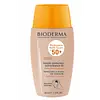What's inside
What's inside
 Key Ingredients
Key Ingredients

 Benefits
Benefits

 Concerns
Concerns

 Ingredients Side-by-side
Ingredients Side-by-side

Zinc Oxide
Cosmetic ColorantDimethicone
EmollientIsododecane
EmollientIsostearyl Isostearate
EmollientButyrospermum Parkii Butter Extract
Skin ConditioningTitanium Dioxide
Cosmetic ColorantPropylheptyl Caprylate
EmollientDipropylene Glycol
HumectantMethyl Methacrylate Crosspolymer
Silica
AbrasivePolymethylsilsesquioxane
Polyhydroxystearic Acid
EmulsifyingWater
Skin ConditioningHdi/Trimethylol Hexyllactone Crosspolymer
PEG-10 Dimethicone
Skin ConditioningCI 77492
Cosmetic ColorantPolysilicone-11
Triethoxycaprylylsilane
Salicylic Acid
MaskingButylene Glycol
HumectantCapryloyl Glycine
CleansingPropyl Gallate
AntioxidantCI 77491
Cosmetic ColorantHydrogenated Lecithin
EmulsifyingCaprylyl Glycol
EmollientDecyl Glucoside
CleansingTocopherol
AntioxidantEctoin
Skin ConditioningMannitol
HumectantXylitol
HumectantZinc Oxide, Dimethicone, Isododecane, Isostearyl Isostearate, Butyrospermum Parkii Butter Extract, Titanium Dioxide, Propylheptyl Caprylate, Dipropylene Glycol, Methyl Methacrylate Crosspolymer, Silica, Polymethylsilsesquioxane, Polyhydroxystearic Acid, Water, Hdi/Trimethylol Hexyllactone Crosspolymer, PEG-10 Dimethicone, CI 77492, Polysilicone-11, Triethoxycaprylylsilane, Salicylic Acid, Butylene Glycol, Capryloyl Glycine, Propyl Gallate, CI 77491, Hydrogenated Lecithin, Caprylyl Glycol, Decyl Glucoside, Tocopherol, Ectoin, Mannitol, Xylitol
Homosalate 10%
Skin ConditioningOctocrylene 7.5%
UV AbsorberEthylhexyl Salicylate 5%
UV AbsorberBenzophenone-3 5%
UV AbsorberAcrylates/Dimethicone Methacrylate Copolymer 3%
EmollientAscorbic Acid
AntioxidantBHT
AntioxidantBisabolol
MaskingButylene Glycol
HumectantC12-15 Alkyl Benzoate
AntimicrobialCamellia Oleifera Leaf Extract
AstringentCaprylyl Glycol
EmollientCetyl Dimethicone
EmollientChlorphenesin
AntimicrobialCyclopentasiloxane
EmollientDiethylhexyl 2,6-Naphthalate
EmollientDisodium EDTA
Ethylhexylglycerin
Skin ConditioningMannan
Neopentyl Glycol Diheptanoate
EmollientPantothenic Acid
Skin ConditioningParfum
MaskingPentylene Glycol
Skin ConditioningPhenoxyethanol
PreservativePolyester-7
Skin ConditioningPolymethyl Methacrylate
Portulaca Oleracea Extract
Skin ConditioningRetinyl Palmitate
Skin ConditioningSilica
AbrasiveSteareth-100
Gel FormingSteareth-2
EmulsifyingStyrene/Acrylates Copolymer
Tocopheryl Acetate
AntioxidantWater
Skin ConditioningXanthan Gum
EmulsifyingHomosalate 10%, Octocrylene 7.5%, Ethylhexyl Salicylate 5%, Benzophenone-3 5%, Acrylates/Dimethicone Methacrylate Copolymer 3%, Ascorbic Acid, BHT, Bisabolol, Butylene Glycol, C12-15 Alkyl Benzoate, Camellia Oleifera Leaf Extract, Caprylyl Glycol, Cetyl Dimethicone, Chlorphenesin, Cyclopentasiloxane, Diethylhexyl 2,6-Naphthalate, Disodium EDTA, Ethylhexylglycerin, Mannan, Neopentyl Glycol Diheptanoate, Pantothenic Acid, Parfum, Pentylene Glycol, Phenoxyethanol, Polyester-7, Polymethyl Methacrylate, Portulaca Oleracea Extract, Retinyl Palmitate, Silica, Steareth-100, Steareth-2, Styrene/Acrylates Copolymer, Tocopheryl Acetate, Water, Xanthan Gum
 Reviews
Reviews

Ingredients Explained
These ingredients are found in both products.
Ingredients higher up in an ingredient list are typically present in a larger amount.
Butylene Glycol (or BG) is used within cosmetic products for a few different reasons:
Overall, Butylene Glycol is a safe and well-rounded ingredient that works well with other ingredients.
Though this ingredient works well with most skin types, some people with sensitive skin may experience a reaction such as allergic rashes, closed comedones, or itchiness.
Learn more about Butylene GlycolCaprylyl Glycol is a humectant and emollient, meaning it attracts and preserves moisture.
It is a common ingredient in many products, especially those designed to hydrate skin. The primary benefits are retaining moisture, skin softening, and promoting a healthy skin barrier.
Though Caprylyl Glycol is an alcohol derived from fatty acids, it is not the kind that can dry out skin.
This ingredient is also used as a preservative to extend the life of products. It has slight antimicrobial properties.
Learn more about Caprylyl GlycolSilica, also known as silicon dioxide, is a naturally occurring mineral. It is used as a fine, spherical, and porous powder in cosmetics.
Though it has exfoliant properties, the function of silica varies depending on the product.
The unique structure of silica enhances the spreadability and adds smoothness, making it a great texture enhancer.
It is also used as an active carrier, emulsifier, and mattifier due to its ability to absorb excess oil.
In some products, tiny microneedles called spicules are made from silica or hydrolyzed sponge. When you rub them in, they lightly polish away dead skin layers and enhance the penetration of active ingredients.
Learn more about SilicaWater. It's the most common cosmetic ingredient of all. You'll usually see it at the top of ingredient lists, meaning that it makes up the largest part of the product.
So why is it so popular? Water most often acts as a solvent - this means that it helps dissolve other ingredients into the formulation.
You'll also recognize water as that liquid we all need to stay alive. If you see this, drink a glass of water. Stay hydrated!
Learn more about Water